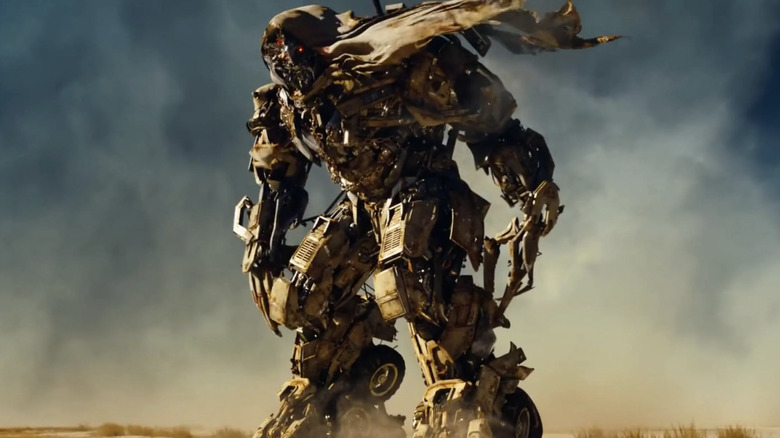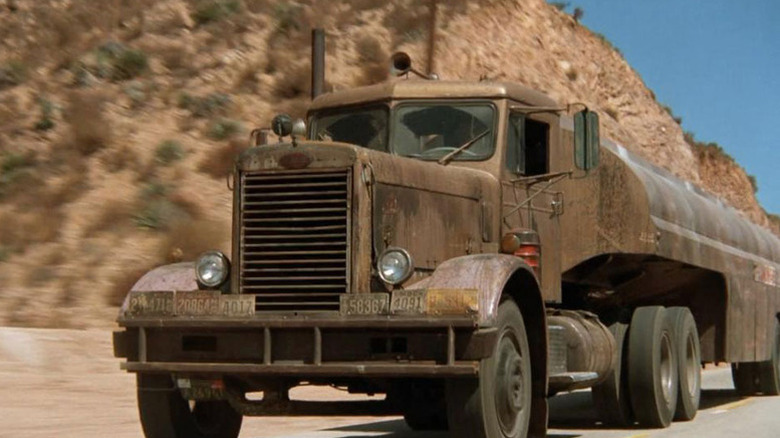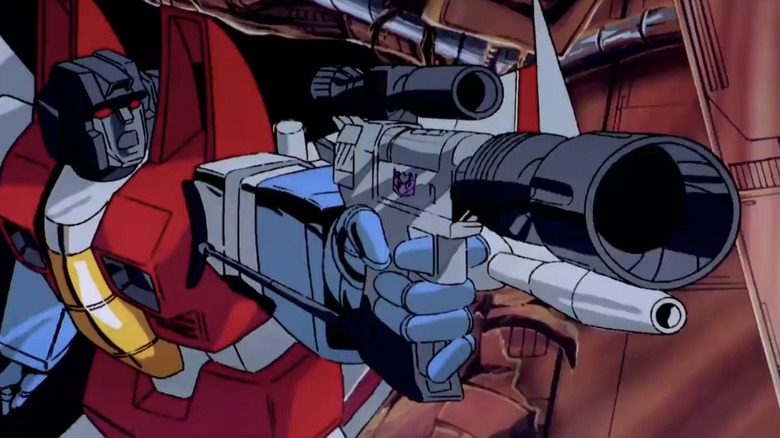Transformers 3 Remodeled Megatron After Steven Spielberg's First Movie Villain
We may receive a commission on purchases made from links.
Steven Spielberg's filmography as a director is long, but his resume as a producer is gargantuan (and definitely not as quality-consistent as his directing career). Case in point: He has executive produced all of the modern "Transformers" films, and recruited Michael Bay to direct the first one. Those movies are definitely more Bay, less 'Berg, but flashes of Spielberg's influence do show up.
The first "Transformers" film, especially, structures itself like "Jaws" and "Jurassic Park" (i.e. holding off on the spectacle in the first half). The heart of that film pulls from Spielberg's playbook as well, depicting an "E.T."-like friendship between Sam Witwicky (Shia LaBeouf) and the Autobot Bumblebee.
"Transformers" wasn't the first time Spielberg was involved with a story all about evil cars. Spielberg's first widely-released feature film, 1971's "Duel," featured a menacing truck, yet it took until "Transformers" 3, 2011's "Dark of the Moon," for that to get an homage in the franchise.
Decepticon leader and villain Megatron (Hugo Weaving) takes quite a beating at the end of "Transformers: Revenge of the Fallen." Optimus Prime (Peter Cullen) rips off Megatron's right arm and then blasts Megatron's face with the villain's own fusion cannon. It would've been easy for the next movie to forget about this. ("Forget" is what most everyone wants to do when it comes to the abominable "Revenge of the Fallen.") "Megatron retreats to lick his wounds, comes back next week" is how every episode of the original "Transformers" cartoon played out, but it doesn't here.
In a surprising bit of continuity for films that usually never cared about that, Megatron has a new look in "Dark of the Moon" and it's not a pretty one. He still has an enormous gash in his head above his right eye; he's taken to wearing a rag as a hood to cover the wound, but when he lowers the hood, you can see parts of his brain. ("Transformers" often gets away with violence/gore like this since the characters are robots.) Megatron's severed arm has also been replaced with a different, more humanoid model, creating asymmetry with his pincer-like left hand.
There are movie references scattered all across Megatron's new body. His new hand resembles Freddy Krueger's clawed glove. His shotgun and vehicle mode, a rusty, beaten-down tanker truck, suggest George Miller's "The Road Warrior" — and the truck looks right out of "Duel," too.
Steven Spielberg's Duel features a driver chased by a mysterious truck
Before jumping to the movies, Spielberg was a television director; this early period saw him direct the first proper episode of "Columbo" in 1971. Later that year, he took one step out of TV and one step into film for "Duel," a TV movie made for "ABC's Movie of the Week."
"Duel" was based on a short story by Richard Matheson, an acclaimed genre writer in the mid-20th century. (Matheson contributed over a dozen episodes to "The Twilight Zone," including "Nightmare at 20,000 Feet.") The film follows David Mann (Dennis Weaver), a salesman on a business trip driving through the Mojave desert. He's pursued by an enormous, rusty Peterbilt 281 tanker truck that is trying to run him off the road for no apparent reason.
It's implied the driver is a serial killer who likes to prey on lone drivers; the truck has numerous license plates adorning it, likely trophies from previous kills. But the driver's motivations, and indeed his face, are never revealed to Mann or the audience. (Before you start thinking this truck might be a Decepticon-like entity all on itself, there is shown to be a driver; in one scene, he leans his arm out the window and encourages Mann to go. We just don't know anything else about him.)
Megatron's truck mode in "Dark of the Moon" is not exactly the same truck as in "Duel." It's a different model (a Mack Granite M915 LHRT) and blade-like fixtures are affixed above the windshield and on the bumper to make it look even meaner. But with Spielberg as a producer on "Dark of the Moon," the similarities stick out more than the differences.
Frankly, it's surprising that "Transformers" took so long to make Megatron transform into a truck. Not because of "Duel," but because his counterpart and archenemy, Optimus Prime, transforms into a tanker truck. Megatron transforming into a dirty, "evil" truck makes him a mirror image of Prime being a clean, friendly-looking truck.
Whereas Optimus Prime's appearance across 40 years of "Transformers" has been pretty consistent (red and blue, turns into a truck, wears a helmet with antennae on the sides and a mouth plate), Megatron's design has often been more flexible.
Here's everything Megatron has transformed into
In the original "Transformers" series, Megatron transformed into a handgun; he'd shrink down so the other Decepticons could fire him. (Pictured above.) When he transformed back into a robot, the scope on his gun form became the all-powerful fusion cannon affixed on his right arm. The live-action "Transformers" movies ditched the gun mode, resulting in a Megatron who barely resembled his classic appearance. No fusion cannon, no "buckethead" helmet, nada.
"Transformers" concept artist Josh Nizzi proposed incorporating the helmet into Megatron's "Dark of the Moon" design, with the idea being Megatron would start wearing it to cover his head wound. The final film went in a different direction, depicting Megatron as decrepit to reflect what was supposed to be his character arc.
Unlike the Autobots and other Decepticons, Megatron retained his original Cybertronian appearance in the first two "Transformers" movies. In the original, he transformed into an alien jet. After his resurrection in "Revenge of the Fallen," he upgraded into a flying tank. Megatron is so proud and disdainful of humans that he didn't lower himself to taking on an Earth vehicle mode.
But in "Dark of the Moon," Megatron has had to suffer the indignity of becoming a robot in disguise, hence the tanker truck. Even the spikes lining his grille and bumper can't disguise how much less imposing that is than Megatron's older forms. Megatron first appears in "Dark of the Moon" transforming from truck to robot, and that conveys he's past his prime; rather than a smooth shift from one shape to another, Megatron grunts in pain as his gears grind and sparks flash across his body.
When treacherous Decepticon lieutenant Starscream (Charlie Adler) gives Megatron some mocking pity, Megatron just barks empty threats, not even backhanding Starscream like he once would. Later in the movie, Megatron is easily overpowered and deposed by the Autobot double agent, Sentinel Prime (Leonard Nimoy).
Megatron's arc, which comes through in the "Dark of the Moon" novelization and comic, is that hitting rock bottom and losing the power to sate his bloodlust has given him time to think. He's decided that the war and everything that followed — betraying his brotherly friend Optimus, leading his beloved homeworld Cybertron to ruin, etc. — wasn't worth it. So in the story's third act, Megatron would come to Optimus' aid to help him defeat Sentinel, then the two would end the war with a truce between Autobots and Decepticons.
In the final film, Optimus simply kills both Megatron and Sentinel. But the set-up for Megatron's face turn is still there in earlier scenes, so that conclusion makes Optimus look just as bloodthirsty as his nemesis. There are compelling ideas behind Megatron's appearance in "Transformers: Dark of the Moon," but the film doesn't fully realize them.


